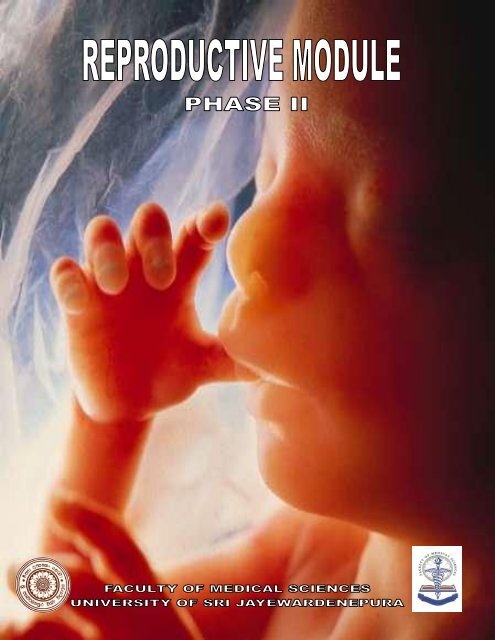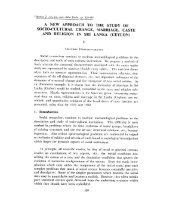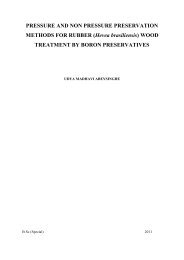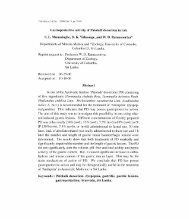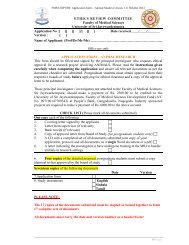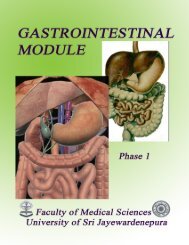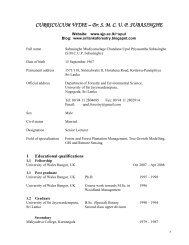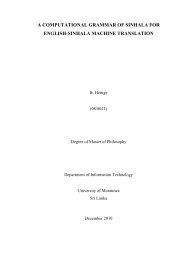reproductive module phase ii - University of Sri Jayewardenepura
reproductive module phase ii - University of Sri Jayewardenepura
reproductive module phase ii - University of Sri Jayewardenepura
You also want an ePaper? Increase the reach of your titles
YUMPU automatically turns print PDFs into web optimized ePapers that Google loves.
REPRODUCTIVEMODULEPHASE IIFaculty <strong>of</strong> Medical Sciences<strong>University</strong> <strong>of</strong> <strong>Sri</strong> <strong>Jayewardenepura</strong>GangodawilaNugegodaReproductive <strong>module</strong> – Phase II Page 2
COMMITTEE MEMBERSChairman:Dr.Ramya PathirajaConvener:Dr. R.C. FernandopulleMembersDr. S.A. JayarathneDr. D. GunasekeraDr. B.M.H.A. BannehekaDr. C.S.E. GoonewardenaDr. R.C. FernandopulleDr. K.C.D.P. SilvaDr.Sharaine FernandoDr. T.A.N. FernandoDr. Kamani GunasekaraReproductive <strong>module</strong> – Phase II Page 3
GENERAL OBJECTIVESOn completion <strong>of</strong> the Reproductive Module, the graduate should be able to:1. Apply the knowledge on the anatomical, physiological and other biologicalphenomena, to understand the congenital anomalies in the genital tract in the maleand the female.2. Diagnose and manage the diseases that affect the breast.3. Apply the principles <strong>of</strong> pathology to understand the disease process that affect the<strong>reproductive</strong> system.4. Diagnose and manage infections that affect the <strong>reproductive</strong> system and developmanagement protocols.5. Describe the <strong>reproductive</strong> health concept.6. Provide the basic care at primary (care at home and at field clinics) and secondarylevel in pregnant women.7. Manage pregnant women and pregnancy related complications, when theypractice on their own after qualifying.8. Manage uncomplicated labour, recognize complications <strong>of</strong> labour, lactation andnormal and abnormal puerperium.9. Care <strong>of</strong> the normal neonate.10. Recognize and manage neonatal problems.11. Understand the concepts and methods available to diagnose gynaecologicalproblems when they practice on their own after qualifying12. Understand the role <strong>of</strong> contraception in promoting <strong>reproductive</strong> health.13. Understand the causes and management <strong>of</strong> infertility.Reproductive <strong>module</strong> – Phase II Page 4
IntroductionThe <strong>reproductive</strong> <strong>module</strong> is a five weeks <strong>module</strong> that you will follow during <strong>phase</strong> two <strong>of</strong> yourmedical curriculum. This <strong>module</strong> will help you to develop a deeper understanding andknowledge <strong>of</strong> the disorders related to the <strong>reproductive</strong> system . You are expected to learn aboutclinical features <strong>of</strong> <strong>reproductive</strong> disorders, and how to arrive at a diagnosis, the clinical course,treatment, follow up and the expected out come. Further more this <strong>module</strong> will introduce you tothe management <strong>of</strong> important neonatal conditions and child health.This <strong>module</strong> should be considered as a guide to the relevant topics but not as a comprehensivecoverage <strong>of</strong> whole subject area. Therefore the emphasis should be on active learning and selfstudy by you using the <strong>module</strong> as a guide.Teaching <strong>of</strong> this <strong>module</strong> will be in the form <strong>of</strong> lectures , tutorials, problem based learning,practicals and teacher-student seminars. The teaching will be conducted jointly by clinical ¶clinical departments <strong>of</strong> the faculty.The assessment will be in the form <strong>of</strong> an end <strong>of</strong> term <strong>module</strong> exam (MCQ) and an end <strong>of</strong> yearsummative assessment.Reproductive <strong>module</strong> – Phase II Page 5
Main content areasReproductive embryologyBreast diseasesDiseases <strong>of</strong> the <strong>reproductive</strong> systemDiagnosis and management <strong>of</strong> the diseases that affect the <strong>reproductive</strong> systemReproductive health conceptMaternal and child health careAnte partum, Intra partum and post partum careContraceptionInfertilityReproductive <strong>module</strong> – Phase II Page 6
OBJECTIVE 1Intermediate ObjectivesDetailed contentsMethod <strong>of</strong>TeachingDurationDepartment1. Recall the <strong>reproductive</strong> embryology A. GametogenesisFertilizationEarly fetal developmentSex differentiationDevelopment <strong>of</strong> femaleAnd male genitaliaSeminar 45 min PhysiologyAnatomy2. Diagnose Intersex and implications on<strong>reproductive</strong> healthB. Chromosomal abnormalitiesGonadal aberrationsEnd organ resistanceFemale intersex3. Female <strong>reproductive</strong> System A. Gonadal abnormalitiesCongenital anomalies <strong>of</strong> thegenital tractUterine abnormalitiesFLM 45 mins Obstetrics &Gynaecology4. Male <strong>reproductive</strong> system A. Scrotal lumpsHerniaHydroceleLecture 45 min SurgeryReproductive <strong>module</strong> – Phase II Page 7
OBJECTIVE 2Intermediate ObjectivesDetailed ContentsMethod <strong>of</strong>TeachingDurationDepartment1. Know w the initial steps to be carried out ina patient presenting with symptoms related tobreast diseasesA. Common presentationsHistory taking from a patientpresenting with breast diseasePBL 45 min SurgeryB. The technique <strong>of</strong> examination <strong>of</strong> apatient presenting with a breast lumpGroup activitySkills lab45 min Surgery2.Diagnose and manage the diseases thataffect the breastA. Pathophysiology <strong>of</strong> common benignand malignant breast diseasesLecturePractical45 min PathologyB. Investigations and treatment options<strong>of</strong> benign breast diseasesManagement <strong>of</strong> commonpresentations / when to referLecture 45 min Surgery-Do-C. Malignant breast diseasesRisk factorsPreventionPresentationInvestigationsStagingTumour markersTreatment optionsScreeningBreast reconstructionComplications <strong>of</strong> breast surgeryFollow up patients with breast cancerLectureTutorial45 min45 minSurgeryPathologyReproductive <strong>module</strong> – Phase II Page 8
OBJECTIVE 3,4,11Intermediate ObjectivesDetailed contents1. Menstrual disorders Physiology <strong>of</strong> puberty andMenstrual cycleMethod <strong>of</strong>TeachingDurationDepartmentTutorial 45 min Physiology2. Infections <strong>of</strong> genitaltractAmenorrhoea-Primary-secondaryDysmenorrhoea- Primary- secondaryDysfunctional uterine bleeding (DUB)MenorrhagiaPathological aspect <strong>of</strong> menstrual abnormalitiesEndometrial HyperplasiaUpper and lower genital tract infectionsAll Sexually Transmittd Infections(STI)HIV/ AIDSTrichomonasLecture 45 min Obstetrics &GynaecologyLecture 45 min Obstetrics &GynaecologyTutorial 45 min Obstetrics &GynaecologyLecture 45 min PathologyPractical3 Lectures 45 minx3 MicrobiologySeminarMicro, Obstetrics &GynaecologyFamily MedicineSTISpecimen collection & transportIdentification <strong>of</strong> organismsPractical 45 min MicrobiologyIReproductive <strong>module</strong> – Phase II Page 9
Intermediate Objectives3. Tumours <strong>of</strong> femalegenital tractDetailed contentBenign and malignant tumours <strong>of</strong>UterusOvaries and tubesVulva and vaginaMethod <strong>of</strong> Teaching Duration Department2 Lectures 45 min x 2 Pathology4. Tumours <strong>of</strong> malegenital tractBenign and malignant tumours2 LecturesPracticalTutorial45 min x 2 SurgeryPathology5. Problems in post<strong>reproductive</strong> lifeUtero vaginal prolapse PBL 45 min Obstetrics &GynaecologyReproductive <strong>module</strong> – Phase II Page 10
OBJECTIVE 5, 6Intermediate ObjectivesDetailed content1. Describe Reproductive Health (RH) concept Definition <strong>of</strong> RHComponents <strong>of</strong> RHFamily Health program in<strong>Sri</strong> Lanka- objectives & strategiesSafe motherhoodMethod <strong>of</strong>TeachingDurationDepartmentLecture 45 min CommunityMedicine2. Organization and delivery <strong>of</strong> maternal & childhealth services <strong>of</strong> <strong>Sri</strong> LankaThe need for maternal & child careThe role <strong>of</strong> MOH, PHN & PHMPre conceptual counselingAntenatal careLecture 45 min CommunityMedicine3. Describe maternal & child health services provideat the field levelClinical activitiesInvestigationsVitamin & Mineral supplementationTetanus toxoidMaintenance <strong>of</strong> records & returnsScreening for high risk conditions &referralNatal careImportance <strong>of</strong> hospital deliveryThe need for trained assistance forhome deliveriesLectureClerkship45 min CommunityMedicineReproductive <strong>module</strong> – Phase II Page 11
4. Describe infant & child healthservices5. Describe activities <strong>of</strong> the wellbaby clinic6. To be able to describe methods<strong>of</strong> minimizing childhoodmortalityChild health services-Institutional & fieldRole <strong>of</strong> public health staff in delivery<strong>of</strong> child health servicesOrganizationFacilities available and delivery <strong>of</strong>servicesCauses <strong>of</strong> infant and childhoodmortalityMethods/ strategies to minimizeLectureClerkship45 min Community MedicineLecture 45 min PaediatricsLecture 45 min Community MedicineDescribe the school healthservicesSchool health programme:-objectives- components- deficienciesClerkshipCommunity Medicine7. Adolescent Health ImportanceHealth, social and mental problemsNutrition8 Describe measures <strong>of</strong>preventing maternal deathsDefine maternal deathCauses <strong>of</strong> maternal mortality /morbidity in SL & global situationFactors contributing to declinematernal mortality in SLFurther reduction <strong>of</strong> deathsInvestigation <strong>of</strong> maternal deathInterpretation <strong>of</strong> autopsy findingsSeminar 45 min Community MedicineObstetrics &GynaecologyPaediatricsFamily MedicineLecture 45 min Community MedicineClerkshipForensic MedicineReproductive <strong>module</strong> – Phase II Page 12
9. Describe activities <strong>of</strong> wellwomen clinicObjectivesActivitiesClerkshipCommunity Medicine10 Describe monitoring andevaluation <strong>of</strong> maternal and childhealth servicesImportance <strong>of</strong> monitoring andevaluation <strong>of</strong> antenatal and postnataland outcome indicatorsClerkshipCommunity MedicineReproductive <strong>module</strong> – Phase II Page 13
OBJECTIVE 7Intermediate Objectives1. Describe maternal physiologicalchanges in pregnancyDevelopment <strong>of</strong> fetus & itsadaptation at birth2. Manage bleeding in pregnancySeptic conditions in pregnancy3. Manage medical disorders inpregnancy-do-Detailed contentsNormal changes in pregnancyFetal developmentAntepartum haemorrhageEctopic pregnancyTrophoblastic diseaseMiscarriagesSeptic miscarriagesHypertensive / renal disordersDiabetes & endocrine disordersCoagulation disordersAnaemiaHeart diseaseInfectionsNutritionPsychiatric & neurologicaldisordersLiver disorders (will bediscussed in GIT <strong>module</strong>)Method <strong>of</strong>TeachingDuration DepartmentSeminar 45 min Obs tetrics&GynaecologyAnatomyPhysiology3 Lectures 45 min x 3 Obstetrics &GynaecologySeminar (<strong>phase</strong> III) 45 min5 LecturesPBLSeminar45 min x 545 min45 minMedicineObstetrics&GynaecologyCommunitymedicinePsychiatryPrinciples in prescribing Seminar 45 min PharmacologyObstetrics &GynaecologyFamily medicineReproductive <strong>module</strong> – Phase II Page 14
4. Describe & manage problems inpregnancy affecting fetal outcomeIntrauterine growthretardation(IUGR)Multiple pregnancyPreterm labourAbnormal presentations (PBL)Past dates (lecture)Fetal distress (PBL)Antenatal management <strong>of</strong> fetalcongenital anomalies (lecture)Intrauterine death (PBL)Rh isoimmunization (tute)4 Lectures5 PBLSeminar (<strong>phase</strong> 111)45 min x 445 min x 545 minObstetrics &GynaecologyReproductive <strong>module</strong> – Phase II Page 15
OBJECTIVE 8Intermediate Objectives1.Management <strong>of</strong> normal labourDetailed contentsDiagnosis <strong>of</strong> labourComponents <strong>of</strong> natural labourMaintenance <strong>of</strong> labourMaintenance <strong>of</strong> partogramMethod <strong>of</strong>TeachingDurationDepartmentLecture 45 min Obstetrics &GynaecologyOxytocic drugs Seminar 45 min PharmacologyObstetrics &Gynaecology2.Management <strong>of</strong> abnormal labour Malposition & malpresentation PBL 45 min Obstetrics &GynaecologyDiagnosis & management <strong>of</strong> maternal injuriesrelated to child birthObstetric operations & proceduresSeminar( <strong>phase</strong> III)45 min Obstetrics &GynaecologyForceps, vacuum & caesarian sectionsVBAC( Vaginal Birth After CaesarianSection)Obstetric emergenciesLecture 45 min Obstetrics &GynaecologySeminar(<strong>phase</strong> III)45 min Obstetrics &GynaecologyReproductive <strong>module</strong> – Phase II Page 16
3.Normal & abnormal puerperiumPhysiology <strong>of</strong> puerperiumComplications <strong>of</strong> puerperiumThird stage <strong>of</strong> labour & its complicationsPPHRetained placentaLectureSeminar( <strong>phase</strong> III)45 min Obstetrics &Gynaecology4.Lactation5.Infant feedingPhysiology <strong>of</strong> lactationEstablishment <strong>of</strong> lactationProblems associated with lactationBaby friendly hospital initiativeTen steps to successful breast feedingBreast feeding:Composition <strong>of</strong> breast milkAdvantages- mother & infantContraindicationsAssessment <strong>of</strong> adequacyFormula feeding:Concepts <strong>of</strong> formula I, II, IIISpecial formulae:Advantages & disadvantagesAbsolute indicationsComplementary feeding(CF) :Concept <strong>of</strong> CFPlanning to CFValue <strong>of</strong> different weaning foods (CF),Kanji, fruit juices, home made CF,commercial CFComposition, constitution, frequency,problems/misconceptionsSeminar 45 min CommunityMedicineLectureClerkshipPaediatricsFamily Medicine45 min PaediatricsReproductive <strong>module</strong> – Phase II Page 17
OBJECTIVE 9, 10Intermediate Objectives1.Care <strong>of</strong> the newborn includingcommon problemsDetailed contentsManagement <strong>of</strong> a term neonate atdelivery & the immediate neonatalperiodNeonatal screeningIdentify & manage :Umbilical sepsis, eye infections,pustulesMethod <strong>of</strong>TeachingDurationDepartmentLecture 45 min Paediatrics2.Diagnosis & management <strong>of</strong>neonatal problemsNeonatal infections Seminar 45 min PaediatricsFamily MedMicrobiologyPrematurity/IUGR/Large for dates baby 3 Lectures45 minx3 PaediatricsNeonatal sepsisNeonatal jaundicePBLBirth asphyxiaNeonatal convulsionsSeminarDiagnosis & management <strong>of</strong> respiratoryDistressSurfactant deficiencyCongenital pneumoniaMeconium aspirationTransient Tachypnoea inNewborn(TTN)Birth asphyxia & meconium aspirationReproductive <strong>module</strong> – Phase II Page 18
OBJECTIVE 12Intermediate Objectives1.Discribe different family planningmethods available in SLDescribe the fertility control policyin S LDetailed contentsHormonal contraceptivesBarrier methodsDevicesMeasures <strong>of</strong> fertilityGoals, Targets & objectivesList advantages <strong>of</strong> family planning(FP)Contraceptive prevalence & FP indicatorsUnmet need <strong>of</strong> family planning(FP)CounselingMethod <strong>of</strong>TeachingSGD (clerkship)DurationDepartmentCommunityMedicine2.Educate the people & promote theuse <strong>of</strong> contraceptivesThe role <strong>of</strong> hospital doctor, MOH, PHN,and midwife in the hospital setting & inthe fieldSeminar 45 min CommunityMedicineFamily MedicineObstetrics &Gynaecology3.Types <strong>of</strong> oestrogens &progesteronepreparations(RECALL)Parentral & oral contraceptivesIndications for their use, mechanisms <strong>of</strong>actions, clinical uses, method <strong>of</strong>administration and adverse effects &contraindicationsDifferent types <strong>of</strong> oral contraceptive pills(OCP) preparationsMechanism <strong>of</strong> action, adverse effects,precautions, contraindications &interactionsPrescribing, CounselingNon contraceptive benefits <strong>of</strong> OCPSGDPharmacologySeminar 45 min PharmacologyFamily MedicineReproductive <strong>module</strong> – Phase II Page 19
4.Describe the other differenttypes <strong>of</strong> methods used byfemales & males includingsurgical methods5.Emergency contraceptivesRhythm methodMethods <strong>of</strong> use, benefits &advantages <strong>of</strong> the different devicesIndicationsContraindicationsDifferent preparations availableHow & when to use themAdverse effects, precautions &contraindications for their useFLM45 minObstetrics &GynaecologyPharmacologyFamily MedReproductive <strong>module</strong> – Phase II Page 20
OBJECTIVE 13Intermediate Objectives1.Background diagnosis &counseling in infertility2.Management <strong>of</strong> Infertility3.Traetment <strong>of</strong> infertility &complicationsDetailed contentsIntroductionPrevention <strong>of</strong> infertilityPlanning a pregnancyInvestigating infertilityCounselingFemale- causesCoital problems, uterine causes,problems with ovulation, cervicalfactorsMale – causesCoital problemsAbnormalities in sperm count rmortalitySexual dysfunctionUnexplained infertilityInvestigation <strong>of</strong> infertilityOvulation inductionAssisted <strong>reproductive</strong> techniqueIntra Uterine Insemination(IUI)Gamete intra fallopiantransfusion(GIFT)In Vitro fertilization (IVF)OHSSMultiple pregnancyMethod <strong>of</strong>TeachingDurationDepartmentSeminar(<strong>phase</strong> III) 45 min Obstetrics&GynaecologyLectureTutorial (<strong>phase</strong> III)Seminar (<strong>phase</strong> III)45 min45 min45 minPsychiatryObstetrics&GynaecologyObstetrics&GynaecologyPsychiatryLecture 45 min Obstetrics&GynaecologyReproductive <strong>module</strong> – Phase II Page 21
Reading MaterialPaediatrics1. Illustrated text book <strong>of</strong> PaediatricsPr<strong>of</strong> Tom Lissaur & GrahamClayden2. Essential Paediatrics – Ghai3. Paediatrics – Anthony de Milner & David HullAnatomy & Physiology1. Langman2. Emery’s element <strong>of</strong> Mdical Genetics –Student notes in Genetics – Young and Muller3. Review <strong>of</strong> Medical Physiology –William F. Ganong 21 st Edition4. An aid to clinical surgery – Williamson Waxman scottReferences1. Moors – developing Embryo2. Before we are born – Essetials <strong>of</strong> Embryology and birth defectsKeith L. Moore, Vid Persand3. Human Genetics – concepts and applications Ricki Lewis4. ABC in GeneticsObstetrics & Gynaecology1. Text book <strong>of</strong> Gynaecology - D.C. Dutta5 th Edition2. Text book <strong>of</strong> Obstetrics - D.C. Dutta5 th Edition3. Gynaecology by Ten teachers – Stuart Campbell, Ash Monga17 th Edition4. Obstetrics by Ten teachers – Stuart Campbell, Christopher Less17 th EditionReproductive <strong>module</strong> – Phase II Page 22
Parasitology1. Basic Clinical Parasitology – 6 th EditionFranklin A. Neva, Harold BrownMicrobiollgy1. Microbiology in clinical practice – D.C. Chanson2. Medical Microbiology – edited by Cedric A Mimms, John H.L.Play fair,Ivan M. Roitt, Derek Wakelin, Rosamind Williams3. Medical Microbiology – 16 th EditionDavid Greenwood, Richard C.B. SluckPathology1. Robbins and Cotran – Pathological basis <strong>of</strong> diseaseKumar, Abbas, Fausto2. Muir’s textbook <strong>of</strong> PathologyMcSween, Whaley3. Textbook <strong>of</strong> PathologyHarsh Mohen4. Concise PathologyChandrasoma, TaylorReproductive <strong>module</strong> – Phase II Page 23


